18 Steps to a mirror in the garden
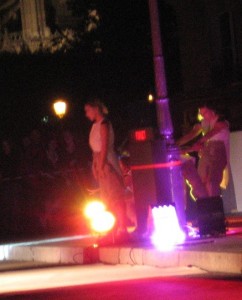
Nuit Blanche avant garde dance troupe
Paris hosts an annual autumn fête called Nuit Blanche (“White Night” or “all nighter”). It is a celebration of art and culture where special events and performances occur throughout central Paris, and galleries and museums are open all night for free. In October 2006, we enjoyed the festivities which included an avant garde dance troupe.
We also discovered an outdoor art exhibit installed in Square Georges Cain: Giardino Sonoro – A Sound Garden in Paris (Un Jardin Sonore a Paris) created by Environmental Design (Florence).The designers used horticultural elements and motion-activated sound to transform the outdoor space into a surreal gallery. Bizarre and amazing!
No video image? Refresh your browser.
New Perspective on Garden Art
Our garden is quieter. A non-urban space embracing stillness, and natural sounds, movements and colors. Nevertheless, the Sound Garden installation impressed me because the art was so integrated into the context of the outdoor gallery, not separate from it. I liked that.
Inspired by man-made artifacts enclosed in a natural setting, my idea was to hang a full-sized mirror in the garden that would reflect back on the garden (sans le son). So that’s what I did. I selected a location on one edge of the garden – two Tupelo trees about 10′ (3m) apart. I set to the task, following these 18 steps to a mirror in the garden.
Create the mounted mirror
The materials are easily available and cheap, and you don’t need an engineering degree to accomplish this.
- Buy a wardrobe mirror at a home goods store (like Target, Lowes, Home Depot), the kind you hang on the back of a bedroom door. About 18″ x 48″ (45cm x 122cm). Mine cost around $5 US.
- Remove the plastic frame around it, leaving just the glass mirror.
- Cut 3/4″ (2cm) outdoor grade plywood the same size as the mirror and paint the back and edges black (I used Krylon Gloss Black spray paint)
- Viewing the plywood board horizontally, measure in from the left and right edges about 6″ (15cm) and 4″ (10cm) from the top. Mark the two spots. This is the interesting part that I discovered after the fact: the board will pivot from these points and tilt slightly downward. I thought I would need to run wire through eye bolts at the bottom, to hold the mirror at an angle. You don’t.
- Drill a 1/4″+ diameter (.6cm+) hole at each spot through the wood, to hold a similar diameter eye bolt. The eye of the eye bolt will face the back of the board; the hanging wire runs through these two eye bolts.
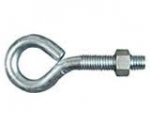
- Counter sink the holes on the front (mirror side) with a 1″ (2.5cm) wood bit so that the nut and washer on the end of the eye bolts will lie below the surface of the surrounding wood. You don’t want any part of the bolt touching the back of the mirror.
- Insert the eye bolts through the back, add a washer, and nut. Tighten.
- Eye the board from an edge perspective to see if the eye bolt or nut protrudes above the board surface. If necessary (it was for me), cut the bolt shorter with a hack saw. This is a fun way to skin your knuckles. Good luck. Maybe one could measure for correct bolt length before hand.
- Use a weather-proof silicone caulk to fill in around the countersunk bolts/nuts. Then, poised with the caulk gun, squirt it all over in ribbons and curly-queues on the surface of the wood that will hold the mirror.
- Place the mirror on the board. Squeeze a bead of silicone caulk around all the edges of the mirror to keep water from penetrating between the mirror and the mounting board. Smooth the caulked edges with a damp cloth – keeping it off the mirror surface! Let everything dry for a couple of days.
Hang the Mounted Mirror
Assuming you’ve selected your two trees from which to hang the mirror, you’ll need wire cable, a ladder, cutters, and probably a buddy.
- For cable I bought medium duty, plastic-coated wire cable (Lowes), general purpose for clothes lines type. 50′ (15m) is good. This cable is easy to work with but tough. The plastic coating reduces friction and protects the cable wire from the elements.
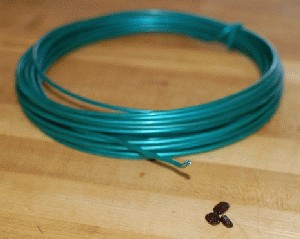
Plastic coated wire cable with three coffee beans
- Create a loop in the wire and fasten it to itself feeding it through an oval swaging sleeve and smashing it with a hammer. Looks like this:
- At tree #1, loop the wire cable around the tree trunk, then pass the line through the loop, like a lasso.
- On your ladder, work the loop up to the height you want. It should just stay put but otherwise, tap a teeny nail to hold it in place while you move the ladder to tree #2. (click to view larger image)
- On the ground, run the end of the wire cable through the back of the mounted mirror eye bolts, like threading a needle. Work the mounted mirror onto the wire cable so the mirror is hanging loosely, one corner on the ground. With slack cable in hand, climb the ladder that is perched against tree #2.
- As gracefully and carefully as possible hold the wire cable even with the height of the cable on tree #1, then wrap the wire cable around the tree. This might take four hands. Eventually you will have wrapped it around tree #2 two or three times.
- Slide the mirror so it’s centered and level between the two trees.
- You can feed the extra wire cable back through the eye bolts for added durability. I did. Cut off the remainder.
These images show the mirror in the garden in three seasons: winter, spring, and summer.
Hanging in there
My mirror in the garden has been hanging since June 2009, and has weathered winds over 50 mph (80 kph). The bottom, untethered edge seems to allow wind to flow beneath it, tilting the mirror back without putting undue strain on the wire cable, at least so far. The green coated wire has dulled to gray. The mirror shines on. What are your garden reflections? Share your views.
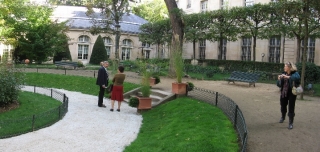
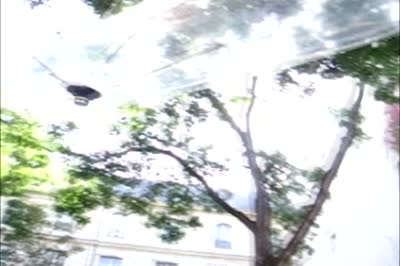
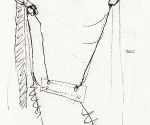

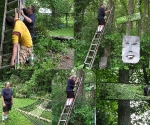
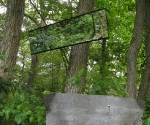 mirror-in-woods-view1
mirror-in-woods-view1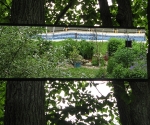 mirror-in-woods-view2
mirror-in-woods-view2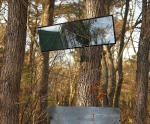 mirror-in-woods-winter
mirror-in-woods-winter
I already love this mirror, but don’t think I realized just how much went into getting it there – impressive!!!
Thanks. What do you think of the idea of adding mirror(s) behind Sarabande?
Great idea….alas in a desert garden it may become a fire hazard! Or blind the neighbors.
You should also keep in mind that a plant will have different branching structures throughout its growth.
If you find it’s difficult for you to install by yourself, you can hired a professional to install these Sprinkler systems for
you quickly and easily. Knowing how to time your purchases at
the right time can save you a lot of money.